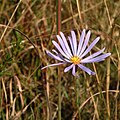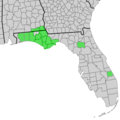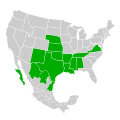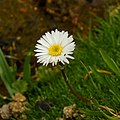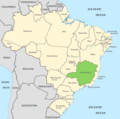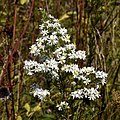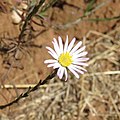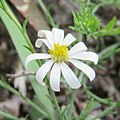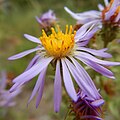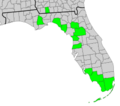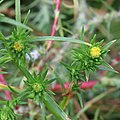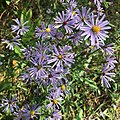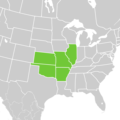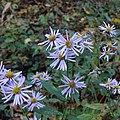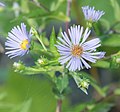Top Qs
Timeline
Chat
Perspective
List of Symphyotrichum species
List of plant species in the aster family From Wikipedia, the free encyclopedia
Remove ads
Symphyotrichum is a genus of flowering plants in the tribe Astereae which includes the commonly cultivated New York aster (S. novi-belgii) and New England aster (S. novae-angliae). Its species are widespread in the Americas, including as far north as subarctic North America to as far south as Chile, Argentina, and the Falkland Islands. One species has a native range extending into eastern Eurasia.
Most of the species in the genus are perennials. The flower heads have white, pink, purple, or blue ray florets surrounding white to yellow disk florets. The disk floret corollas become pink, purple, or brown after pollination. The three species in section Conyzopsis have reduced or absent ray florets.
Symphyotrichum is the type genus of subtribe Symphyotrichinae. There are 98 species in the genus, some with varieties, and thirteen named hybrids. The genus is split into five subgenera: Chapmaniana, Astropolium, Virgulus, Ascendentes, and Symphyotrichum. Most of the species had been classified within the genus Aster until it was confirmed to be polyphyletic. The American asters now are separated into monophyletic genera based on multiple phylogenetic studies.
Remove ads
Conventions
Summarize
Perspective
NatureServe conservation categories
Conservation status codes follow the NatureServe conservation (NS) rounded global status scheme. Hybrids have a column for parents in place of conservation status. Not listed (NL) is not a NatureServe category but is used here to represent those left out of global status rankings up to G5 (including GNA and GNR) and those not in NatureServe. Type species for each clade are in a separate table.
Remove ads
Classification
Summarize
Perspective
Classification of Symphyotrichum
|
Subtribe Symphyotrichinae contains six genera. In addition to Symphyotrichum, these are Almutaster, Ampelaster, Canadanthus, Psilactis,[1] and Sanrobertia,[2] with Symphyotrichum being the largest at 98 species and thirteen named hybrids. The cladogram presented here for the subtribe is based on a combination of cytotaxonomic and morphologic data reported in multiple studies.[1][2][3] Symphyotrichum is the type genus of the subtribe.[4]
|
Classification within Symphyotrichum
Most of the species had been classified within the genus Aster until it was confirmed to be polyphyletic – as previously defined, the genus Aster contained groups of species with different most recent ancestors. The American asters were then separated into several genera based on morphological characteristics and phylogenetic studies.[5][6]
Within Symphyotrichum, S. novae-angliae and S. turbinellum are monotypic within sections. S. novae-angliae is classified in the subgenus Virgulus. In 1994, it was placed in section Grandiflori, subsection Polyligulae.[7] In 2002, it was segregated within its own section Polyliguli.[8] The list follows the 2002 circumscription of section Polyliguli for the species. S. turbinellum is classified in the subgenus Symphyotrichum. It has been placed within its own section Turbinelli.[8] It was previously placed in section Symphyotrichum, subsection Turbinelli.[9] The list follows the more recent circumscription of section Turbinelli for the species.
Clades
- Symphyotrichum subg. Chapmaniana (Semple) Semple[8]
- Symphyotrichum subg. Astropolium (Nutt.) Semple[8]
- Symphyotrichum subg. Virgulus (Raf.) G.L.Nesom[10]
- Symphyotrichum subg. Ascendentes (Rydb.) Semple[8]
- Symphyotrichum subg. Symphyotrichum[13]
Species classifications
-
Symphyotrichum subg. Chapmaniana[ref 1]: 133subg. Astropolium[ref 1]: 133subg. Virgulus[ref 2]: 272subg. Symphyotrichum[ref 2]: 267sect. Conyzopsis[ref 2]: 271sect. Occidentales[ref 2]: 271sect. Turbinelli[ref 1]: 133sect. Symphyotrichum[ref 2]: 268Cladogram references
- Semple, J.C.; Heard, S.B.; Brouillet, L. (2002). "Cultivated and Native Asters of Ontario (Compositae: Astereae)". University of Waterloo Biology Series. 41. Ontario: University of Waterloo: 1–134.
- Nesom, G.L. (September 1994). "Review of the Taxonomy of Aster sensu lato (Asteraceae: Astereae), Emphasizing the New World Species". Phytologia. 77 (3) (published 31 January 1995): 141–297. ISSN 0031-9430. Retrieved 23 August 2021 – via Biodiversity Heritage Library.
- Sugbenus Ascendentes is made up of two allopolyploid species with historic parents from subg. Virgulus and subg. Symphyotrichum.
Remove ads
Species list
Summarize
Perspective
Subgenus Chapmaniana
Subgenus Astropolium
Subgenus Virgulus
Subgenus Virgulus (Raf.) G.L.Nesom[10]
Section Ericoidei
Section Patentes
Section Patentes (Torr. & A.Gray) G.L.Nesom[11]
Subsection Brachyphylli
Subsection Patentes
Section Grandiflori
Section Grandiflori (Torr. & A.Gray) G.L.Nesom[7]
Subsection Mexicanae
Subsection Grandiflori
Section Polyliguli
Section Concolores
Subgenus Virgulus named hybrids
Subgenus Ascendentes
This subgenus contains two allopolyploid species derived from the historic hybridization of plants from the subgenera Symphyotrichum and Virgulus.[62]
Subgenus Symphyotrichum
Section Conyzopsis
The three species in section Conyzopsis have reduced or absent ray florets.[65]
Section Occidentales
Section Turbinelli
Section Symphyotrichum
Subsection Dumosi
Subsection Heterophylli
Subsection Heterophylli (Nees) Semple[8]
Series Concinni
Series Cordifolii
Subsection Porteriani
Subsection Symphyotrichum
Series Punicei
Series Symphyotrichum
Subgenus Symphyotrichum named hybrids
Remove ads
Notes
- Hybrids do not have their own articles.
- Elevation in the May Prairie State Natural Area
- Elevation on the island of Grand Bahama
- This is a county map of east central Texas showing the range of S. eulae as described by Lloyd Herbert Shinners. Darker green shaded counties were in Shinners' 1950 protologue of Aster eulae. Lighter green shaded counties are within the area covered by Shinners' description. Darker green counties are, alphabetically, as follows: Bexar, Calhoun, Cooke, Dallas, Denton, Hill, Hunt, Kaufman, Navarro, Rockwall, Tarrant, Wise, and Wood.[80] The following counties are shaded lighter green because they are within Shinners' range but are not specifically named by him: Anderson, Austin, Bastrop, Bell, Bosque, Brazos, Burleson, Caldwell, Collin, Colorado, Comal, Coryell, DeWitt, Ellis, Falls, Fayette, Freestone, Goliad, Gonzales, Guadalupe, Hays, Henderson, Hood, Jack, Johnson, Karnes, Lavaca, Lee, Leon, Limestone, Madison, McLennan, Milam, Parker, Rains, Robertson, Smith, Somervell, Travis, Van Zandt, Victoria, Waller, and Washington. Williamson, and Wilson.[82] Only McLennan County is green on the S. eulae page in the USDA PLANTS database.[81]
- There is also an extensive presence of Symphyotrichum × salignum in Europe and western Asia in the following countries: Assam, Austria, Baltic States, Belarus, Belgium, Bulgaria, Czechoslovakia, Denmark, Finland, France, Germany, Great Britain, Hungary, Ireland, Italy, Kazakhstan, Krym, Netherlands, Norway, Poland, Romania, Spain, Sweden, Switzerland, Tadzhikistan, Ukraine, Uzbekistan, and Yugoslavia.[17]
Remove ads
Citations
References
Wikiwand - on
Seamless Wikipedia browsing. On steroids.
Remove ads


